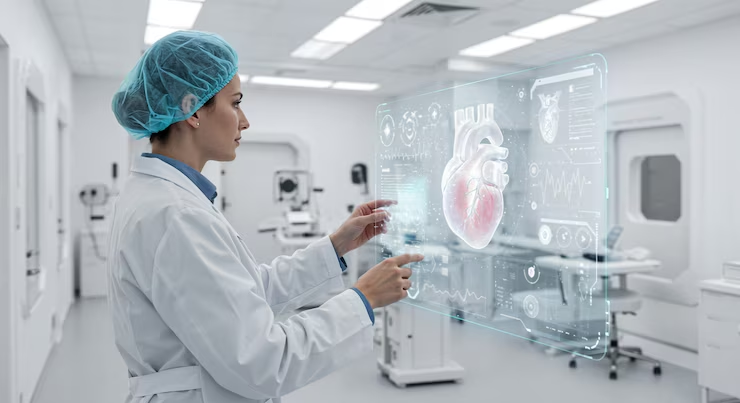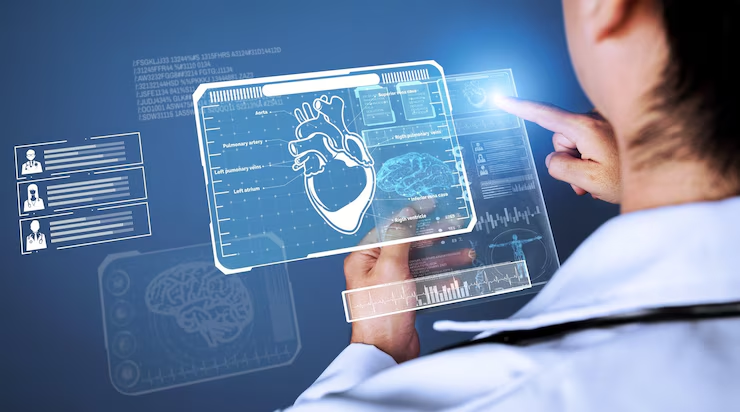Home Case Study AI-Driven Digital Transformation in Cardiac Imaging for a Healthcare Company
Healthcare
AI-Driven Digital Transformation in Cardiac Imaging for a Healthcare Company

Focus Areas
Artificial Intelligence (AI) in Healthcare
Cardiac Imaging & Diagnostics
Digital Transformation

Business Problem
A healthcare company specializing in cardiology services faced challenges in managing increasing imaging volumes, lengthy diagnostic turnaround times, and inconsistent accuracy in cardiac image interpretation. Manual processes strained radiology teams, limited scalability, and led to delays in diagnosis and treatment planning. The organization needed to modernize its imaging workflows using AI to enhance diagnostic precision, improve clinician productivity, and accelerate patient care.
Key challenges:
- Manual Image Interpretation: Radiologists were burdened with high workloads and variability in analysis accuracy.
Workflow Bottlenecks: Lack of automation led to slow case processing and reporting delays.
Data Fragmentation: Imaging data and patient records were stored across siloed systems with limited interoperability.
Scalability Issues: Growing patient demand could not be efficiently met with existing tools and manual processes.
Compliance & Privacy: The organization needed a secure, HIPAA-compliant AI implementation.
The Approach
Curate collaborated with the healthcare company to integrate AI-driven cardiac image analysis tools into the existing clinical workflow. This involved automating diagnostic tasks using deep learning, streamlining data access, and enhancing real-time collaboration between radiologists and cardiologists. The transformation reduced interpretation times, improved accuracy, and enabled faster, data-driven clinical decisions.
Key components of the solution:
Discovery and Requirements Gathering:
Stakeholder Alignment: Worked with radiology, cardiology, IT, and compliance teams to identify pain points and regulatory constraints.
System Assessment: Reviewed PACS/RIS, EMR, and imaging modalities to determine integration readiness.
Key Goals Defined:
Implement AI for cardiac image segmentation and anomaly detection
Integrate imaging insights with patient health records
Automate reporting and reduce diagnostic delays
Ensure regulatory compliance and data security
AI & Workflow Integration:
AI Model Deployment: Integrated deep learning models (e.g., U-Net, ResNet) to perform automatic segmentation of cardiac structures and detect abnormalities such as left ventricle dysfunction or aortic stenosis.
Workflow Orchestration: Developed end-to-end workflows using Python-based orchestration and DICOM-compatible AI pipelines for real-time inference.
Data Integration: Connected PACS/RIS and EMR systems via HL7 and FHIR standards to ensure seamless data flow and reporting.
Clinical Dashboard: Designed a centralized interface showing AI-derived insights alongside traditional radiologist inputs for faster review and collaboration.
Process Optimization and Enablement:
Automated Report Generation: Structured, AI-assisted findings were automatically populated into radiology reports, reducing manual entry.
Flagging & Prioritization: AI flagged critical cases (e.g., severe ejection fraction anomalies), enabling priority triaging.
Quality Assurance Loop: Radiologists could review and provide feedback on AI outputs to refine model accuracy.
Training & Adoption: Conducted onboarding sessions for radiologists and cardiologists on AI interpretation and workflow usage.
Stakeholder Engagement & Change Management:
Iterative Rollout: Deployed in pilot phases across multiple cardiac imaging centers, refining with clinician feedback.
Clinical Champions: Engaged key physicians to advocate for adoption and guide workflow alignment.
Governance & Oversight: Established an AI oversight committee to monitor performance, compliance, and bias mitigation.
Business Outcomes
Accelerated Diagnostic Turnaround
Average image interpretation time dropped significantly, enabling faster treatment planning and reducing patient wait times.
Improved Diagnostic Accuracy
AI-assisted segmentation and detection improved precision in identifying cardiac anomalies, reducing variability across radiologists.
Optimized Resource Allocation
Radiology teams focused on complex cases while AI handled routine interpretations, enhancing productivity and scaling capacity.
Secure, Compliant Data Processing
All data workflows were HIPAA-compliant, with encrypted transmission, audit trails, and access controls
Sample KPIs
Here’s a quick summary of the kinds of KPI’s and goals teams were working towards**:
| Metric | Before | After | Improvement |
|---|---|---|---|
| Average interpretation time (per scan) | 18 minutes | 6 minutes | 67% faster |
| Diagnostic accuracy (EF measurements) | 85% | 95% | 10% improvement |
| Radiologist throughput (cases/day) | 25/day | 40/day | 60% increase |
| Critical case triage time | 45 minutes | 10 minutes | 78% reduction |
| Report preparation time | 15 minutes | 3 minutes | 80% reduction |
Customer Value
Faster, More Accurate Diagnoses
Reduced delays and errors in cardiac assessments.
Scalable Care Delivery
AI-enabled automation allowed the organization to scale services without increasing staff workload.
Sample Skills of Resources
AI/ML Engineers: Developed and fine-tuned deep learning models for cardiac image analysis.
Healthcare Data Scientists: Translated clinical goals into data models and measurable outcomes.
Systems Integrators: Ensured seamless interoperability across EMR, PACS, and AI platforms.
Compliance Specialists: Oversaw privacy, security, and regulatory adherence.
Clinical Consultants: Guided workflow alignment and validated AI output relevance.
Tools & Technologies
AI Frameworks: TensorFlow, PyTorch
Imaging Standards: DICOM, HL7, FHIR
Cloud Platforms: AWS (SageMaker, EC2), GCP (Vertex AI)
Visualization & BI: Power BI, custom web dashboards
Integration Tools: Mirth Connect, Apache NiFi
Collaboration: Confluence, Microsoft Teams, Jira

Conclusion
Through AI-powered transformation, the healthcare company significantly enhanced its cardiac imaging workflows—delivering faster, more accurate diagnoses while improving clinical efficiency. By combining advanced machine learning with robust data integration and governance, Curate helped the organization reimagine its diagnostic processes, improve patient outcomes, and scale its services sustainably in a digitally evolving healthcare landscape.
All Case Studies
View recent studies below or our entire library of work

Securing Multi-Cloud Kubernetes Environment for a SaaS Provider
TECHNOLOGY & SOFTWARE Securing Multi-Cloud Kubernetes Environment for a SaaS Provider Focus Areas Kubernetes Security Multi-Cloud Architecture DevSecOps Enablement Business Problem A SaaS provider delivering

Enhancing User Engagement for a Social Media Platform through Advanced Data Analytics and API Development
Marketing & Sales Enhancing User Engagement for a Social Media Platform through Advanced Data Analytics and API Development Focus Areas Advanced Data Analytics User Engagement

Enhancing Digital Visibility and Mobile Experience for a Marketing Firm
Marketing & Sales Enhancing Digital Visibility and Mobile Experience for a Marketing Firm Focus Areas Digital Presence Optimization Mobile Experience Design SEO & Performance Analytics

Data-Driven Audience Segmentation to Boost Customer Retention
Marketing & Sales Data-Driven Audience Segmentation to Boost Customer Retention Focus Areas Data Analytics Audience Segmentation Customer Retention Business Problem A subscription-based e-commerce company was